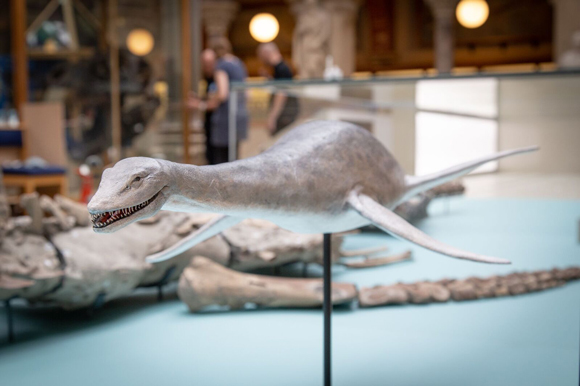New Plesiosaur Genus named in honour of Dr Elizabeth “Betsy” Nicholls
A new plesiosaur discovered in Alberta, Canada has been named Nichollsia borealis in honour of Dr Elizabeth Nicholls who sadly passed away in 2004. Dr Nicholls was a member of the Royal Tyrrell museum research team staff for 14 years and much admired by her fellow palaeontologists and researchers. Her energy, enthusiasm and fascination for palaeontology was the stuff of legend, regularly commuting long distances to work at the museum and journeying to some of the most remote and inhospitable parts of the Canadian wilderness in her search for fossils.
Dr Elizabeth Nicholls
The book “Dinosaur Provincial Park – A Spectacular Ancient Ecosystem Revealed”; edited by Phillip Currie and Eva Koppelhus is dedicated to her memory.
This new genus of Plesiosaur (marine reptile) was discovered in 1994 by machine operators working underground digging through a sandstone deposit at Syncrude’s Base mine, near Fort McMurray, Alberta. Despite the near completeness of the specimen (left forelimb and scapula missing), the fossil was not named and described until recently. The paper on this new animal has just been published in the German scientific journal Palaeontographica Abteilung A.
The Alberta Oil Sands
The mines in this part of Alberta have attracted a lot of controversy, the sediments being mined, known as the Alberta oil sands are producing crude oil, part of a global trend to search for oil and natural gas from oil sands, oil shales and deep ocean deposits, reserves that are more and more difficult to reach. More oil companies are turning to these unconventional sources of fossil fuels as demand for them begins to outstrip supply.
Environmentalists have lobbied against such activity, the sites tend to be very polluting and there is a higher cost of extraction. Those in favour of such mining argue that with dwindling reserves in the Middle East there is a need to utilise existing technology to explore and exploit new sources of oil and natural gas.
Just occasionally, these miners discover fossils that shed light on the fauna and flora of the Cretaceous.
Plesiosaur Specimen
This specimen measures just under 3 metres in length and dates from approximately 112 million years ago (Aptian/Albian faunal stages). During this period the eastern part of the super-continent Laurasia, effectively the land mass that was to become North America, was split into as sea levels rose. A warm, shallow, tropical sea was eventually formed; this is called the Western Interior Seaway, at its greatest extent it covered Mexico, much of the mid USA and a huge central swathe of what was to become Canada.
A Plesiosaur Exhibit on Display at a Museum

A replica of a long-necked plesiosaur swims into view. Picture credit: Everything Dinosaur.
Picture credit: Everything Dinosaur
Nichollsia borealis was probably an active swimmer, an open water predator chasing down fish in the waters. Close examination of the sharp, needle-like, overlapping teeth indicate that they would have been ideally suited for catching and holding slippery fish.
The relatively large orbits are perhaps an adaptation for hunting in low light levels and their position in the skull indicate that this animal would have been good at judging distances, an important skill if you are going to hunt by striking at swiftly moving fish. The fossil provides important information on the evolution of plesiosaurs as the fossil record for these marine reptiles is relatively poor from the mid Cretaceous.
On Display at the Royal Tyrrell Museum
The fossil has just been placed on display at the Royal Tyrrell Museum, Drumheller, Alberta, Canada. We are sure Dr Nicholls would have felt immensely proud to have a marine reptile named after her on display at the Royal Tyrrell, an institution where she spent so much of her working life.
A former student of the University of Calgary, Dr Nicholls is perhaps most well known for her work on marine vertebrates. She conducted an extensive study and review of marine vertebrate fossils from Manitoba, Canada in the 1970s and went on to help in the discovery and excavation of the largest ichthyosaur fossil known to date.
A Giant Ichthyosaur
Discovered in a remote part of British Columbia in the late 1990s, Dr Nicholls and her colleagues over the period 1999-2001 gradually removed the huge beast from its surrounding matrix. The ichthyosaur is estimated to have measured 23 metres in length, it has been dated to the Triassic and has been ascribed to the genus Shonisaurus. The animal had no teeth in its elongated snout. It was a filter feeder, feeding on phytoplankton and zooplankton, plus other small free swimming marine organisms, like a modern baleen whale or a bashing shark. Much of this specimen is now stored in the vast warehouse area of the Royal Tyrrell museum.
For models and replicas of prehistoric marine creatures: CollectA Prehistoric Life Models.
Betsy Nicholls first decided that she wanted to be a palaeontologist when aged nine she visited the offices of Sam Wells, a university classmate of her father’s. Later she wrote a letter to Roy Chapman Andrews of the American Museum of Natural History (the discover of the first dinosaur nests amongst other things). She wrote asking how a girl could become a palaeontologist. She kept Andrew’s encouraging letter as a treasured memento.
Although Dr Nicholls worked on a number of dinosaur discoveries within the Dinosaur Provincial Park, her first love was marine reptiles. It is only fitting that a newly discovered plesiosaur should be named in her honour.
Nichollssaura borealis
Update
The genus name had to be changed, as Nichollsia was already in use, it described a genus of isopods (marine crustaceans). In 2009, the scientific name for this plesiosaur was changed to Nichollssaura borealis.


